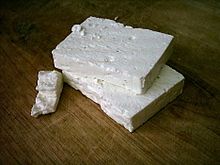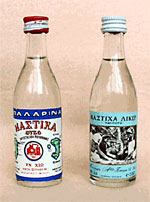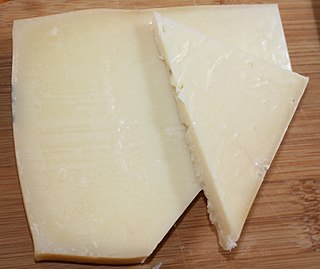This article needs additional citations for verification .(December 2009) |

Greece produces many food products.
This article needs additional citations for verification .(December 2009) |

Greece produces many food products.

Greece is the world's fifth ranked producer of olive oil, producing more than 1,079,000 tons of olive oil annually, more than 75% of that extra virgin. Greek olive oil is exported throughout the world. [1]
Olive oil plays an important role in the Greek diet, being the basis of many dishes.
Honey in Greece is mainly flower-honey from the nectar of fruit and citrus trees (lemon, orange, bigarade trees), thyme honey, and pine honey from conifer trees.


Greece is a heavy producer and consumer of wine.

Greek cuisine is the cuisine of Greece and the Greek diaspora. In common with many other cuisines of the Mediterranean, it is founded on the triad of wheat, olive oil, and wine. It uses vegetables, olive oil, grains, fish, and meat, including pork, poultry, veal and beef, lamb, rabbit, and goat. Other important ingredients include pasta, cheeses, lemon juice, herbs, olives, and yogurt. Bread made of wheat is ubiquitous; other grains, notably barley, are also used, especially for paximathia. Common dessert ingredients include nuts, honey, fruits, and filo pastries. It continues traditions from Ancient Greek and Byzantine cuisine, while incorporating Balkan and Italian influences.
Ouzo is a dry anise-flavored aperitif that is widely consumed in Greece. It is made from rectified spirits that have undergone a process of distillation and flavoring. Its taste is similar to other anise liquors like pastis, sambuca, rakı and arak.

Tsipouro is an un-aged brandy from Greece and in particular Thessaly, Epirus, Macedonia, and the island of Crete. Tsipouro is a strong distilled spirit containing 40–45% alcohol by volume and is produced from either the pomace or from the wine after the grapes and juice have been separated. It comes in two types, pure and anise-flavoured, and is usually not aged in barrels, although barrel aged versions do exist.

Meze or mezze is a selection of small dishes served as appetizers in much of West Asia, Middle East and the Balkans. Meze is often served as a part of multi-course meals. They are popular in the Levant, Iran, Greece, Turkey, the Caucasus and the Balkans.

Mizithra or myzithra is a Greek whey cheese or mixed milk-whey cheese from sheep or goats, or both. It is sold both as a fresh cheese, similar to Italian ricotta, and as a salt-dried grating cheese, similar to Italian ricotta salata. The ratio of milk to whey usually is 7 to 3.
Rakia, Rakija, Rachiu or Raki, is the collective term for fruit spirits popular in the Balkans. The alcohol content of rakia is normally 40% ABV, but home-produced rakia can be stronger.

Pomace spirit is a liquor distilled from pomace that is left over from winemaking, after the grapes are pressed. It is called marc in both English and French, but "grappa" in Italian and "bagaço" in Portuguese. In Spanish it is called orujo. Alcohol derived from pomace is also used as the traditional base spirit of other liquors, such as some anise-flavored spirits. Unlike wine brandy, most pomace brandies are neither aged nor coloured.
Romanian cuisine is a diverse blend of different dishes from several traditions with which it has come into contact, but it also maintains its own character. It has been mainly influenced by Turkish and a series of European cuisines in particular from the Balkans, or Hungarian cuisine as well as culinary elements stemming from the cuisines of Central Europe.

Mastika or mastiha is a liqueur seasoned with mastic, a resin with a slightly pine or cedar-like flavor gathered from the mastic tree, a small evergreen tree native to the Mediterranean region. In Greece, mastiha or mastichato is a sweet liqueur produced with the mastika resin from the Greek island of Chios, which is distilled after hardening to crystals. Sugar is typically added. It is a sweet liqueur that is typically consumed at the end of a meal. It has a distinctive flavor, reminiscent of pine and herbs. It is claimed to have medicinal properties and to aid digestion.

Cypriot cuisine is mainly influenced by Greek and Turkish cuisines, whilst also sharing similarities with the cuisines of Italy and France.

Kefalotyri or kefalotiri is a hard, salty white cheese made from sheep milk or goat's milk in Greece and Cyprus. A similar cheese Kefalograviera, also made from sheep or goat milk, is sometimes sold outside Greece and Cyprus as Kefalotyri. Depending on the mixture of milk used in the process the color can vary between yellow and white.

Tsikoudia, also often called raki in the eastern part of Crete, is an alcoholic beverage, a fragrant, grape-based pomace brandy of Cretan origin that contains 40% to 65% alcohol by volume. Tsikoudia is made by distilling of pomace, what remains of grapes pressed in winemaking. The pomace ferments for about six weeks in a tightly sealed barrel, and is then distilled.

Anari is a fresh mild whey cheese produced in Cyprus. Although much less known than other Cypriot cheeses, it gained popularity following publicity. One of the main industrial producers on the island won a silver medal award for anari in the 2005 World Cheese Awards in the UK. It has since become available in UK national supermarkets.

Mastic is a resin obtained from the mastic tree. It is also known as tears of Chios, being traditionally produced on the island Chios, and, like other natural resins, is produced in "tears" or droplets.

The traditional cuisine of Abruzzo is eclectic, drawing on pastoral, mountain, and coastal cuisine. Staples of Abruzzo cuisine include bread, pasta, meat, cheese, and wine. The isolation which has characterized the region for decades has ensured the independence of its culinary tradition from those of nearby regions. Local cuisine was widely appreciated in a 2013 survey among foreign tourists.

Rakı or raki is an alcoholic drink made of twice-distilled grapes. It is the national drink of Turkey. It is also popular in other Balkan countries as an apéritif as well as in Kazakhstan. It is often served with seafood or meze. It is comparable to several other alcoholic beverages available around the Mediterranean and the Middle East, e.g. pastis, ouzo, sambuca, arak and aguardiente.